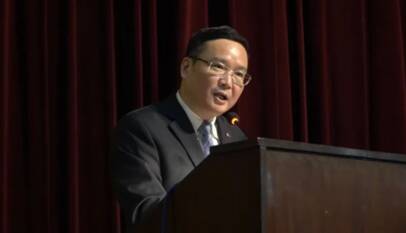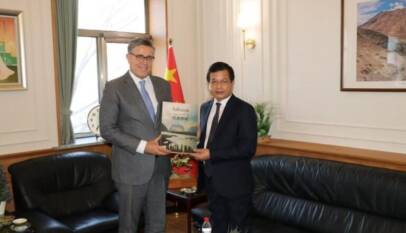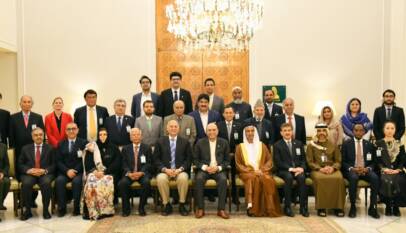CPEC: Symbol of regional integration
The concept of globalisation can well be defined as global interconnectedness, which is achieved through regional connectivity. The regional connectivity in turn is achieved through the development of communication network between two or more states and even within the boundaries of a state. In summary, the essence of globalisation is interconnectedness, achieved through world-wide, “Widening, deepening and speeding up” of communication. This entire process further integrates the world on all three aspects; the political, economic and social. Overall, the entire process can be interpreted as the ‘time and space compression’, where physical distances though remain same, but, squeesed through the construction and development of roads/highways, corridors and railways.
China Pakistan Economic Corridor (CPEC), though conceived a decade earlier, but formalised into a treaty in 2014 is one such project which would initially promote interconnectedness between China and Pakistan, but has the plans and potentials for regional integration within South Asia and areas of Central and West Asia. As per the British geographer, Halford John Mackinder, who talked about the, heartlands and geographic pivots in his famous article, “The Geographical Pivot of History,” Pakistani geopolitical position fits into the definition of geographic pivot, connecting various regions of Asia, politically as well as economically.
As part of Chinese ‘One Belt, One Road’ strategy, the CPEC, once fully constructed would integrate India, Afghanistan, Central Asia and West Asia. Through India, other states of South Asia will be direct and indirect beneficiary of the CPEC. The economies of these countries would be connected to the other region of Asia and even with the global economy. This fact is very much known to India, but, its enmity and rivalry with Pakistan and China in the main factor, where it opposes the concept of CPEC.
Indeed, the CPEC is not a new concept, rather a continuation and expansion of the Karakorum Highway (KKH), constructed in 1970s through 1980s by Pakistan and China through difficult and very high altitude terrain. It is the same KKH which will be expanded to the level of corridor; the CPEC. Gilgit-Baltistan (GB), which India considers is part of the disputed state of Jammu and Kashmir has the right to develop and economically grow. The CPEC will further enhance the opportunities for the economic and socio-political development of the GB and other areas, which so far remained backward, somehow. Why should, India oppose development of a community and area, just for the reason that, it has illegally occupied a major portion of the state of Jammu and Kashmir.
If India is so much worried over its disputed status, then it should come forward and resolve this dispute in the light of UN resolutions and as pr the wishes of the people of Kashmir. As a major regional country, India should take initiative of resolution of issues and try to promote regional integration. Otherwise, there is dichotomy in the statements of Indian leaders. Indian High Commission to Pakistan said that, “India has no worry over the construction of Pakistan-China Economic Corridor as an economically strong Pakistan would bring stability in the region.” The India External Affairs Minister, Sushma Swaraj said in statement that, “Government has seen reports with regard to China and Pakistan being involved in infrastructure building activities in Pakistan Occupied Kashmir (POK), including construction of China-Pakistan Economic Corridor. Government has conveyed its concerns to China about their activities in Pakistan Occupied Kashmir, and asked them to cease such activities.”
India needs to correct its perception on the regional and bilateral issues through the prism of regional integration and prosperity rather through the mindset of rivalry and enmity. CPEC will boost the regional integration and economic prosperity, the benefits of which would be for all and India being a major economy will be the major beneficiary. If India can ask for a transit trade route for its economic linkages with Central Asia through Afghanistan, and is a partner of the TAPI, there should be no reason of India opposing the CPEC through political statements and promoting the terrorism along the route of CPEC. Pakistan otherwise has raised a security division for the physical protection of CPEC.
Apart from Indian, Iran should be made as one of the stakeholder of the CPEC. There has been an economic deal between China and Iran in January 2016. Since Chinese 70% oil transportation is either from Iran or other West Asian states and the African countries, all passing through the Strait of Hormouz. The huge hydrocarbons of Iran have their utility in the economically progressing countries; China being the biggest energy consumer and India being the second in Asia. The IP gas pipeline has potentials to be further extended to China and CPEC will be the best suited route as energy corridor. Besides, Iran, the Central Asian states have the huge potentials and reserves for the contribution to sale in the international markets; China and India being the most energy needy states.
Indeed, CPEC is a project, which would be the initiator for the long-term regional integration, not between Pakistan and China, but in South Asia and various regions of Asia. This is possible only once the regional states; energy deficient and energy efficient correctly re-asses their future priorities. A well thought-out and deliberated economic integration would pave the way for a greater political integration and social prosperity; a step towards resolution of issues and to bring an end to the existing mistrust among the neighbours in wider Asia.
— The writer is International Relations analyst based in Islamabad.
Chinese Ambassador highlights significance of Third Plenary Session for China-Pakistan cooperation
The Third Plenary Session of the 20th Central Committee of the Communist Party of China ha…










